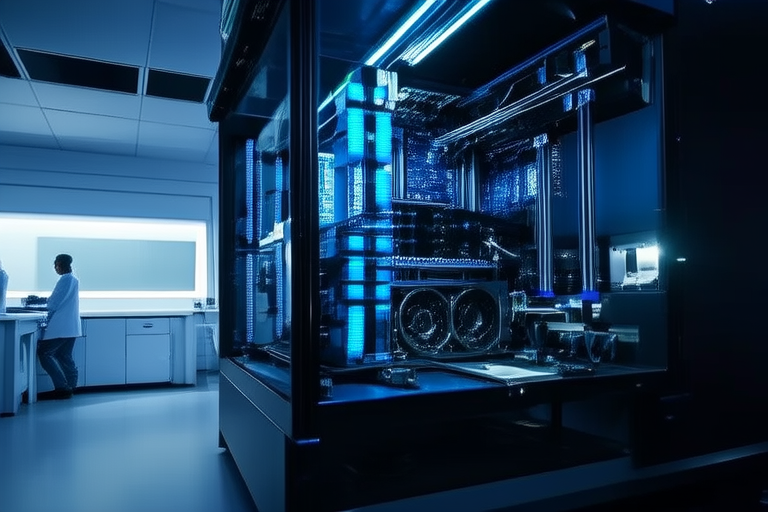“`html
The Quantum Leap: Exploring Innovations in Quantum Computing
Introduction
Quantum computing represents a paradigm shift in the way we process information. Unlike classical computers, which rely on bits to represent data as either 0 or 1, quantum computers utilize qubits that can exist in multiple states simultaneously thanks to the principles of superposition and entanglement. This capability allows quantum computers to solve certain problems exponentially faster than their classical counterparts.
The concept of quantum computing has been around since the early 1980s when physicist Richard Feynman proposed the idea of simulating quantum systems using quantum computers. Since then, numerous milestones have been achieved, including the demonstration of Shor’s algorithm for factoring large numbers and Grover’s algorithm for database searching. These breakthroughs have cemented quantum computing’s status as a revolutionary technology poised to transform industries and scientific research.
Fundamentals of Quantum Computing
Qubits: At the heart of quantum computing lies the qubit, the quantum equivalent of a bit. While a classical bit can only be in one of two states (0 or 1), a qubit can exist in a superposition of both states at once. This property enables quantum computers to process vast amounts of information simultaneously.
Superposition: Superposition refers to the ability of a qubit to be in multiple states at the same time. Imagine flipping a coin — while it’s spinning, it’s neither heads nor tails but a combination of both possibilities. Similarly, a qubit can be in a superposition of 0 and 1 until measured, at which point it collapses into one of the two states.
Entanglement: Entangled qubits are pairs or groups of qubits whose states are linked together. Changing the state of one qubit instantaneously affects the other, regardless of distance. This phenomenon, famously described by Einstein as “spooky action at a distance,” is crucial for performing complex calculations and creating secure communication channels.
Quantum Gates: Just as classical computers use logic gates to manipulate bits, quantum computers use quantum gates to manipulate qubits. These gates perform operations on qubits, allowing them to interact and compute results. By combining various quantum gates, researchers can build circuits capable of solving intricate problems.
Together, these principles allow quantum computers to perform complex calculations more efficiently than classical computers, making them ideal for tackling problems that would otherwise require impractical amounts of time and resources.
Current State of Development
Today, quantum computing is still in its infancy, but significant progress has been made. Companies like IBM, Google, and Microsoft are leading the charge in developing practical quantum computers. In 2019, Google announced achieving “quantum supremacy,” where a quantum computer performed a calculation that would take the world’s most powerful supercomputer thousands of years to complete.
IBM has been particularly active in advancing the field. They have developed the IBM Q System One, a fully integrated universal quantum computing system designed for business and science. Meanwhile, Microsoft is focusing on topological qubits, which are less susceptible to errors caused by environmental interference.
Recent breakthroughs include improvements in qubit coherence times, error correction techniques, and algorithms that leverage quantum advantages. These advancements bring us closer to realizing the full potential of quantum computing.
Potential Applications
Quantum computing holds immense promise across various fields:
Cryptography
Quantum computers could break widely used encryption schemes like RSA by factoring large numbers quickly. However, they also offer new methods of encryption based on quantum mechanics, such as quantum key distribution, which ensures secure communication.
Drug Discovery
Simulating molecular interactions at the atomic level is computationally intensive for classical computers. Quantum computers can model these interactions more accurately, accelerating the discovery of new drugs and treatments.
Optimization Problems
Many real-world problems involve optimizing complex systems, such as scheduling logistics or designing efficient supply chains. Quantum algorithms like the Quantum Approximate Optimization Algorithm (QAOA) can find better solutions faster than classical methods.
Artificial Intelligence
Quantum machine learning algorithms can enhance pattern recognition and data analysis, enabling more accurate predictions and insights. For example, quantum neural networks could improve image and speech recognition systems.
Materials Science
Understanding material properties at the quantum level is essential for developing advanced materials. Quantum computers can simulate these properties more precisely, aiding in the design of stronger alloys, better semiconductors, and novel catalysts.
Challenges and Limitations
Despite its potential, quantum computing faces several technical challenges:
- Error Rates: Current quantum computers suffer from high error rates due to noise and imperfections in qubits. Developing robust error correction techniques is critical for building reliable quantum systems.
- Decoherence: Qubits are highly sensitive to their environment, causing them to lose their quantum state over time. Extending coherence times is vital for performing long computations.
- Scalability: Building large-scale quantum computers requires integrating millions of qubits while maintaining control and minimizing errors. Overcoming scalability barriers remains a major hurdle.
Ethical considerations also arise with the widespread adoption of quantum computing. For instance, the ability to break encryption poses security risks, necessitating new cryptographic protocols. Additionally, the environmental impact of manufacturing and operating quantum computers must be carefully managed.
Future Prospects
The future of quantum computing looks promising. Advances in hardware, such as improved qubit designs and error correction methods, will enhance performance and reliability. Software and algorithms tailored for quantum processors will unlock new applications and capabilities.
Over the next decade, we can expect to see hybrid systems combining classical and quantum computing resources, allowing for more efficient problem-solving. As quantum computers become more powerful, they will likely revolutionize industries and drive innovation across multiple sectors.
Conclusion
Quantum computing represents a quantum leap in technology, offering unprecedented computational power and versatility. From cryptography to drug discovery, its potential applications are vast and transformative. While challenges remain, ongoing research and development are paving the way for practical, scalable quantum computers.
As we continue to explore this exciting frontier, the future of quantum computing holds great promise for society and industry. Whether it’s solving complex scientific problems or enhancing everyday technologies, the impact of quantum computing will be profound and far-reaching.
“`


